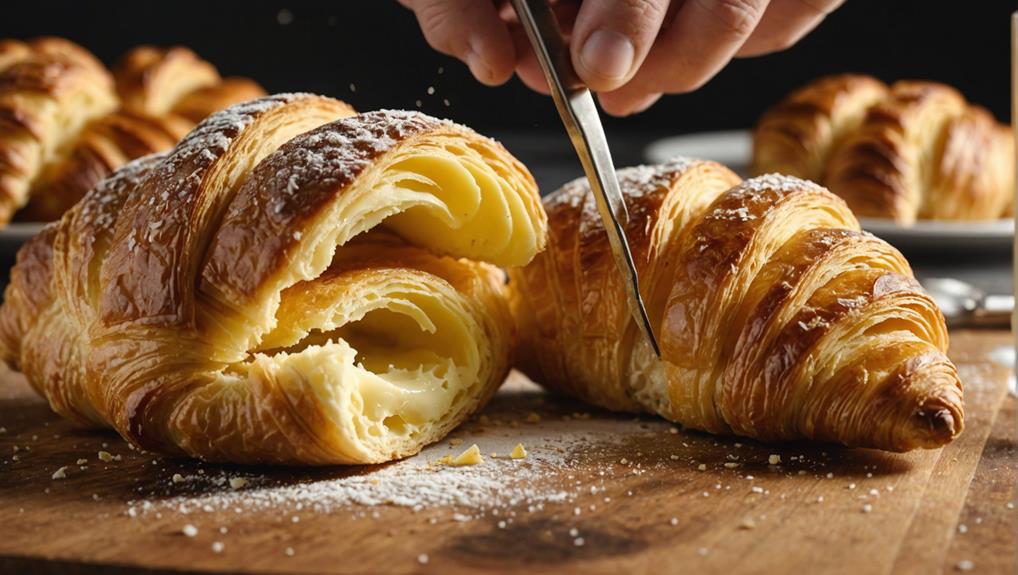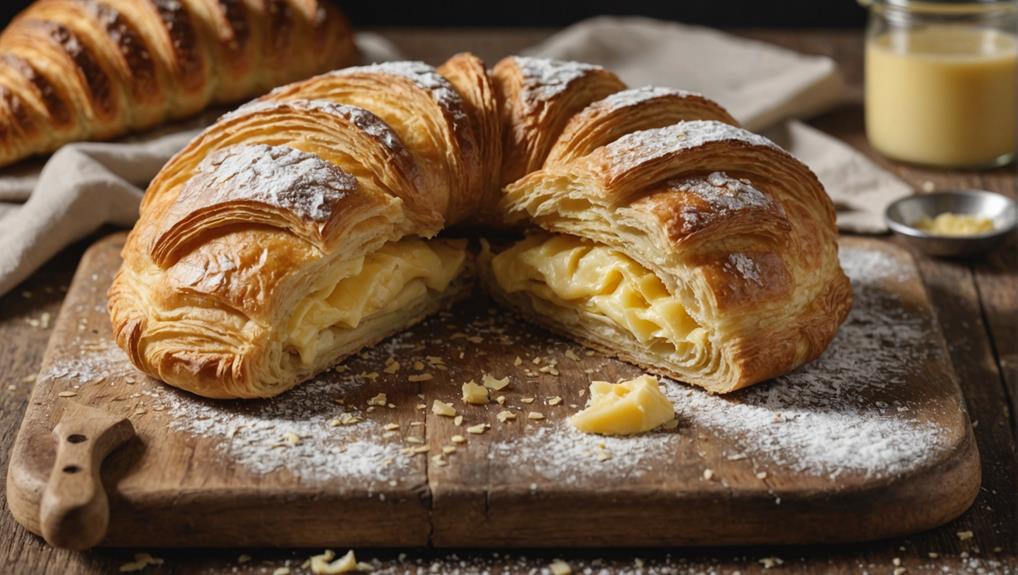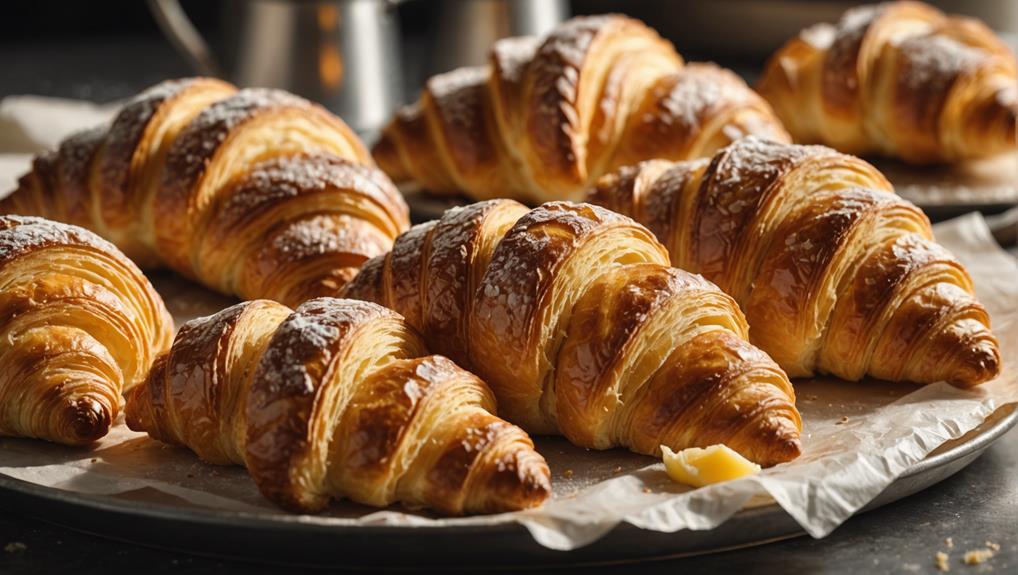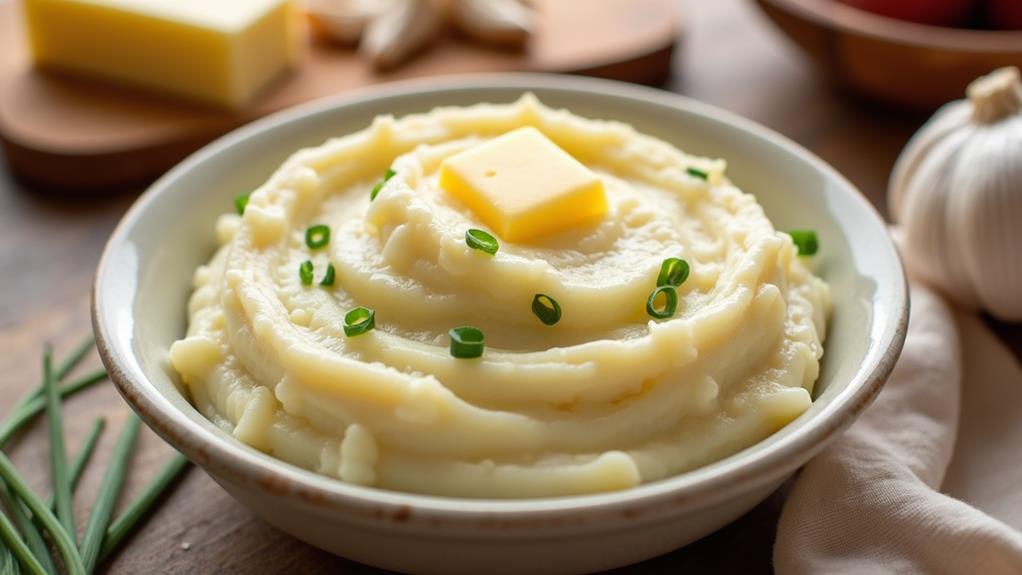To achieve flaky pastry perfection, you'll need to master the delicate balance of ingredients, temperature control, and precise techniques. Start with high-fat butter, keeping it cold throughout the process. The lamination method, which involves folding butter into layers of dough, is crucial for creating that sought-after honeycomb structure. Maintain a 3:4 fat-to-flour ratio and use cold ingredients to prevent gluten development. Quick handling and proper chilling between turns are essential for preserving the integrity of your layers. By focusing on these key elements, you'll be well on your way to crafting irresistibly flaky pastries. The secrets to pastry perfection await your exploration.
Understanding the Role of Butter
When it comes to achieving flaky pastry perfection, butter is your secret weapon. This essential ingredient, with its high-fat content, is the key to creating those delectable layers that melt in your mouth.
As you embark on your pastry-making journey, understanding the role of butter is crucial for innovation in the kitchen.
Butter's magic lies in its ability to create air pockets during baking. When you incorporate cold yet pliable butter into your dough and roll it into thin layers, you're setting the stage for flakiness.
During the baking process, the butter melts, creating steam that separates the layers and results in that coveted texture.
To maximize butter's potential, focus on temperature control. Keep it cold throughout the rolling process to maintain layer integrity.
Some chefs even recommend freezing butter before use. This ensures it doesn't mix with the dough, which would lead to a dense pastry rather than a light, flaky one.
Opt for high-fat European-style butter to enhance flavor and flakiness.
Mastering the Lamination Process
Every aspiring pastry chef must master the art of lamination to achieve truly flaky pastry perfection. The lamination process is the key to creating those delicate, airy layers that define exceptional puff pastry and croissants.
You'll need to fold and roll cold butter into layers of dough multiple times, using your rolling pin with precision and care. As you work, you're crafting a honeycomb structure that will expand during baking, resulting in the coveted flaky texture.
To innovate in pastry making, you must understand the science behind lamination. Keep your ingredients cold throughout the process to prevent the butter from melting into the dough, which would compromise the layered structure.
Aim for at least four turns, chilling the dough between each to maintain consistency. This meticulous approach ensures that when your creation hits the oven, steam will form between the layers, causing them to puff up beautifully.
The result? A pastry that's light, airy, and irresistibly flaky – a true testament to your skill and attention to detail in the art of pastry making.
Temperature Control for Optimal Results

Mastering temperature control is essential for achieving optimal results in pastry making. To create flaky pastries that melt in your mouth, you'll need to embrace the power of cold. Keep all your ingredients, including flour, butter, and water, chilled to prevent gluten development.
When you're working with dough, time is of the essence. As soon as you notice the butter starting to soften, it's crucial to refrigerate the dough. This preserves the layered structure that's key to achieving that coveted flakiness.
Don't rush the chilling process. Allow your dough to rest in the refrigerator for at least 30 minutes. This step ensures proper hydration and gluten relaxation, resulting in a tender pastry that's a pleasure to bite into.
In warm environments, handle the dough quickly to maintain the integrity of the lamination layers. One pro tip: use ice water when mixing your dough. This innovative approach helps you control consistency without overworking, minimizing gluten development and maximizing flakiness.
Precise Technique for Creating Layers
To achieve the epitome of flaky pastry, you'll need to master the art of lamination. This innovative technique involves folding and kneading cold butter into dough, creating distinct layers that result in a heavenly, flaky texture.
Begin by maintaining a precise fat-to-flour ratio of 3:4, ensuring optimal layering and flakiness in your pastry. It's crucial to keep all ingredients, including flour, butter, and water, cold throughout the process to prevent gluten development and preserve those delicate layers.
Roll out your dough into a rectangle, then place the butter block in the center. Fold the dough over the butter, sealing the edges tightly to create layers. This is where the magic happens!
Remember, refrigeration between turns is essential to maintain the right temperature and prevent the butter from melting. By keeping your dough cold, you'll ensure that the layers remain distinct during baking.
With practice and attention to detail, you'll soon be crafting pastries with perfectly flaky layers that will impress even the most discerning palates.
Achieving the Perfect Flakiness

Nailing the perfect flakiness in pastry hinges on a delicate balance of ingredients and technique. To achieve the ideal flaky pastry, you'll need to master the art of combining fat and flour in a 3:4 ratio, aiming for a fat content of 70-75%. This precise ratio ensures optimal layering and texture in your pastry.
- Use cold ingredients to prevent gluten development
- Employ quick mixing techniques with a touch of acid
- Handle the dough gently to avoid overmixing
Cold ingredients are crucial for maintaining a tender and flaky texture. By using chilled butter and flour, you'll inhibit gluten formation, which is key to achieving the perfect flakiness.
Remember to incorporate a small amount of lemon juice to enhance tenderness further. After mixing, refrigerating the dough for at least 30 minutes allows for proper hydration and gluten relaxation. This step is essential for creating those coveted layers in your pastry.
Be mindful not to overwork the dough, as excessive gluten development can lead to toughness. By following these techniques and paying attention to the details, you'll master the art of creating irresistibly flaky pastries that will impress even the most discerning palates.
Frequently Asked Questions
What Is the Science Behind Flaky Pastry?
You'll create flaky pastry by mastering butter layers, controlling dough temperature, and minimizing gluten development. Experiment with fat types, rolling techniques, and resting times. Balance moisture, perfect your baking method, fine-tune ingredient ratios, and enhance flavors for innovative results.
What Is a Fact About Flaky Pastry?
You'll find the golden ticket to heavenly pastry in the butter ratio and dough folding. Master temperature control, use pastry flour, perfect your rolling technique, and respect rest time. Layering method, baking time, ingredient quality, and pastry tools complete the innovation.
What Makes a Flaky Pastry Difficult to Achieve?
You'll find achieving flaky pastry challenging due to precise ingredient ratios, butter temperature control, and proper dough resting. Your rolling technique, flour type, mixing method, and chilling time are crucial. Don't overlook humidity effects, oven temperature, and pastry thickness.
What Is the Fault of Flaky Pastry?
Like a delicate butterfly's wings, flaky pastry's fault lies in its fragility. You'll falter if you mishandle butter temperature, pastry layers, rolling technique, dough hydration, ingredient ratios, baking time, chilling process, oven temperature, or moisture control. It's a balancing act.
Final Thoughts
You've now unlocked the secrets to flaky pastry perfection. Remember, it's all about the butter, the lamination, and the temperature. Master these elements, and you'll create pastries that are light, airy, and irresistibly crisp. Practice your technique, be patient with the process, and soon you'll be turning out professional-quality treats. Whether you're baking croissants, pies, or Danish pastries, these principles will elevate your baking game. Embrace the art of flaky pastry, and delight in your delicious creations.















